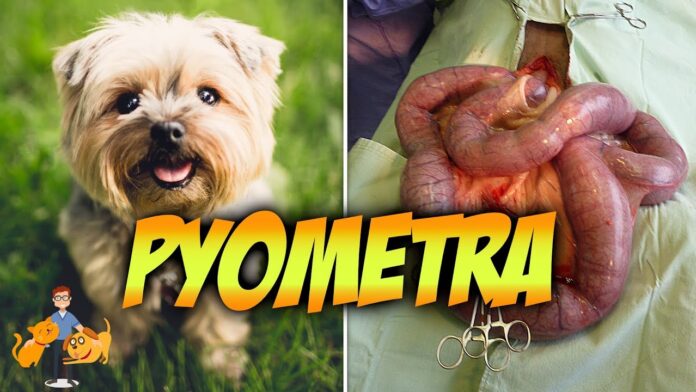Therapeutic Management of Open Pyometra in a Bitch
Accumulation of purulent material within the uterus is referred to as pyometra. This occurs during the luteal phase when a corpus luteum (CL) is present. Because there is no pregnancy, this luteal phase is often called a ‘pseudopregnancy’ because it lasts 40 days rather than the full 63 days of pregnancy. Incidence of pyometra in the cat is much lower than the bitch where 20% of females will develop pyometra by age 10.1 Pyometra developed in 2.2% European cats by the age of 13 years.2 Lower incidence of pyometra in the cat is likely due to less overall prolonged progesterone exposure since they are induced ovulators, have a shorter nonpregnancy luteal phase (40 days) and are seasonal. Pyometra occurs in middle age or older queens, 3 – 4 weeks after ovulation (spontaneous, induced, or mated), and can be life threatening.
Canine pyometra is a common pathological affection of intact bitches depicting pus in the uterus (Chastain et al., 1999) . There are two type of pyometra, closed and open. In open pyometra, cervix of the animal remains open while in closed pyometra the cervix is closed. The cases with close cervix pyometra are more toxic than those in which discharge is present i.e. open pyometra. In most of cases, the treatment of choice is ovariohysterectomy, but surgery is a radical form of treatment that prevents any further reproduction. In order to conserve the breeding capability of valuable females, medical treatment can be attempted which usually involved the repeated administration of prostaglandin Meyers-Wallen et al. (1986) . Hence, keeping in views of the above mentioned facts the present case was treated.
Case History and Clinical Observations
A bitch of breed German shepherd aged 4 years, weight 30 kg, was presented to our pet clinic with the complains of anorexia, elevated body temperature of 104F, lethargy, depression, polydipsia, vomiting, bloody vaginal discharge so called tomato soup color and malodorous. On hematological examinations, leucocytosis (26000 cell/µl) & decrease haemoglobin (8.5g/dl) were recorded while blood biochemical profile revealed elevated level of SGPT (129.68 IU/L), Blood Urea Nitrogen (38.95mg/dl) and total protein (9.01g/dl) and decreased blood glucose (49.56 mg/dl) level. So, the case was tentatively diagnosed as open pyometra case.
Treatment and Discussion
The bitch was treated with injection of Dinoprost Tromethamine (Lutalyse™ ,Pfizer Ltd., Mumai, India) @ of 100µg/ Kg body weight was given twice daily by subcutaneously for five days along with supportive therapy like injection Ceftiofur Sodium (Xyrofur™ Intas pharmaceutical co,) @ 2mg /Kg. body weight once daily for five days by subcutaneously route to eliminate the bacterial infection, inj. Metoclopramide (Perinorm, IPCA) @ 0.1mg/kg body weight was given twice daily by i/m route for three days to control over the vomiting and 2 ml of inj. B-Complex (Conciplex ™Concept Pharma Co.) was given once daily by i/m route for five days. Later after three days, the digestive syrup Vitazyme two teaspoon twice daily after meal was prescribed to induced appetite. Seven days later the bitch was recovered successfully.
Similar findings were reported by Dr Shanker Singh who used dinoprost tromethamine for treatment of canine pyometra. There was found increasing in haemoglobin level indicated resolution of anemia on day 8. The TLC, hemoglobin and TP level were returned to near normal level. Present finding is inagreement with Schepper et al. (1987) who used natural PGF2α for the treatment of pyometra and observed normal serum biochemistry in all the treated bitches at completion of treatment. The cured bitch was conceived when mated in successive cycles.
The another similar cases were treated by injection intacefTazoa (Ceftriaxone Sodium and Tazobactum Sodium@20 mg/kg body weight for 4-6days ,I/M ,IntacefTazoa (565mg for 4-6 days intrauterine. Supportive treatment include injection Melonexa 2ml for 3 days I/M injection Tribivet vitamin B1 B6 B12and 2ml for 5 days I/M two bitches complete clinical recovery after 4 days of treatment . No reoccurrence of pyometra were reported in cured cases and all bitches conceived when mated subsequently
The bitch was treated successfully by using natural PGF2α and antimicrobials along with supportive therapies. The medical treatment of pyometra can be attempted where the breeding capability of the animal is desired to be conserved. If treatment is not performed quickly, the toxic effect from the bacteria will be fatal.
Compiled & Shared by- Team, LITD (Livestock Institute of Training & Development)
Image-Courtesy-Google
Reference-On Request.
Disclaimer: The information contained in this article of Pashudhan Praharee is not intended nor implied to be a substitute for professional Veterinary action which is provided by your vet. You assume full responsibility for how you choose to use this information. For any emergency situation related to a Pet’s health, please consult your Regd. Veterinarian or nearest veterinary clinic.



